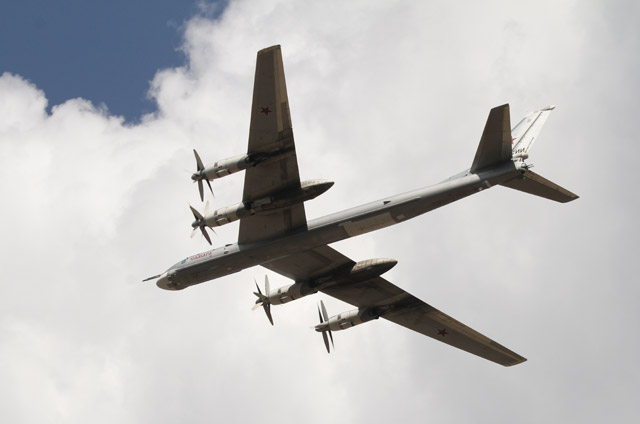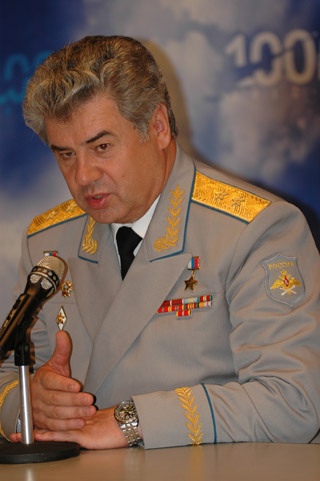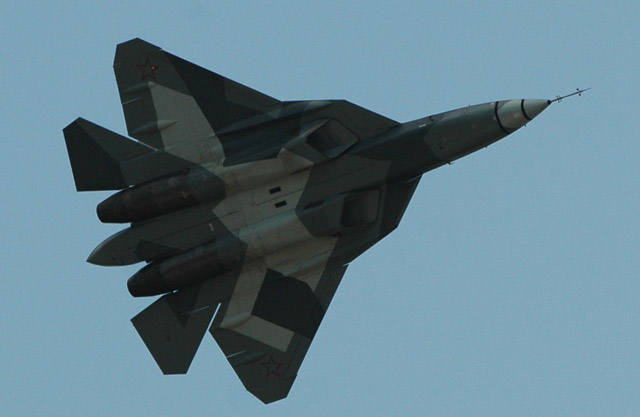Confirmation came on the occasion of the Russian air force centennial celebrations in August. Addressing media, air force commander-in-chief Lt Gen Victor Bondarev revealed that development of a new strategic bomber, the PAK-DA, had commenced. Its name is a Russian acronym that approximates to "future aviation complex for long-range aviation", and the aircraft is intended to supplement and partially replace the Tupolev Tu-160s, Tu-95MSs and Tu-22M3s now forming the backbone of Russia's land-based strategic bomber fleet.
 |
|---|
Vladislav Perminov |
Touching on a recent meeting with Russia's president, Vladimir Putin, during which long-term procurement issues were discussed, Bondarev happily observes that the air force enjoys priority in the current equipment purchase plans set out in the GPV-2020, the government's most recent defence procurement programme. Putin assured him that the air force will get everything on its wish list, and pledged support to the PAK-DA project.
"The defence ministry is working on a complete range of requirements for the PAK-DA, and after these are firmed up, the industry will be able to complete the technical shape of this aircraft", Bondarev says. Russia is also working on "strategic UAVs" as part of shaping "sixth-generation aircraft", which, according to Bondarev, will largely be unmanned and "with built-in intellect".
EARLY DESIGN
Lt Gen Anatoly Zhikharev, commander of long-range aviation, says PAK-DA flight testing will commence in 2022. An early design has been completed and accepted, and the industry is now doing full-scale research and development work on the aircraft.
 |
|---|
"The defence ministry is working on a complete range of requirements for the PAK-DA Lt Gen. Victor Bondarev |
Besides, various Russian scientific institutions, among them TsAGI (Central Aerohydrodynamic Institute), have been working on technologies of undoubted interest to designers working on the PAK-DA. In particular, TsAGI did intensive wind-tunnel testing on the Sova future hypersonic vehicle (capable of reaching a speed of Mach 5) and collaborated on domestic and European projects on future supersonic business jets, with the focus on sonic boom suppression and drag reduction.
According to Russian media reports, PAK-DA development began in earnest in 2010. Initial studies dated back to 2007, when the Russian air force handed Tupolev a set of technical requirements for a future long-range bomber. Funding for this project was allocated in the state defence budget of 2008 and was subsequently confirmed in GPV-2015 and then GPV-2020. In 2009 the defence ministry awarded Tupolev a three-year R&D contract to undertake concept studies and research that would facilitate shaping of the aircraft's aerodynamics and systems architecture.
In August this year the air force announced that it had approved an early design of the PAK-DA and that industry could go ahead with adapting the design "to various tactical and technical requirements". Cutting metal on technology demonstrators and/or development prototypes is expected in 2015, and series production around 2020. The first squadrons could then introduce the new type in 2025. However, industry sources suggest the new bomber can, realistically, be built no earlier than 2025, and that the development cycle could require at least 15-20 years.
VARIED ROLE
Neither the PAK-DA concept nor its performance targets have been revealed in public. It may well be that the air force has not yet issued a final specification. What is known for sure is that PAK-DA must be able to fulfil various roles in all-out nuclear war or non-nuclear conflict, using a wide arsenal of precision-guided munitions (PGMs). As the defence ministry puts it, the PAK-DA must have a set of "combat capabilities of a new quality, to execute all-new methods of deterrence". In terms of construction, the new bomber will be built using advanced materials, including composites, and the stealthy aircraft will be designed from scratch. It will carry all-new weaponry specially developed for the aircraft.
Although not directly related to PAK-DA, an ongoing discussion in Russia about the need to develop a "second generation of hypersonic weapons" may have some relevance to the planned bomber. Compared to the "first generation" - such as the in-service Onix surface-strike missile and its Indian version, the BrahMos PJ-10 - the next generation will fly three or four times faster, at M10-12, speeds necessary to overcome modern air defences. But the nature of such weapons means high drag and fuel burn. A difficult-to-detect bomber could get superfast but short-legged missiles closer to the battleground.
As of mid-2012, the Russian air force had 66 combat-ready intercontinental bombers, not counting those undergoing repair and modernisation or on training duties. These comprised 11 Tu-160s and 55 Tu-95MS, with some 200 nuclear charges (although this fleet can carry more). The latter types are undergoing modernisation, which is centred on fitting them with new long-range subsonic cruise missiles. Most of these bombers were built in the 1980s and 1990s and have logged a relatively small number of flight hours. They could therefore remain in service until 2030-2040, and beyond, suggesting that the PAK-DA, if it arrives on time, may be deployed in different roles to those allocated to the Tu-95MS and Tu-160. Presumably, the air force will be more interested in a harder-to-detect bomber able to penetrate through modern air defences and suppress them.
By large, the Russian and US air forces' strategic bomber inventories are similar. Both services have three major types. The B-52H and Tu-95MS play the role of heavy lifters, able to take a huge load of cruise missiles - the Tomahawk and its Russian equivalents the Kh-55 and Kh-101 - and deploy them before getting within firing range of enemy anti-aircraft systems. Albeit very different technically, the B-2A and Tu-160 are both intended to penetrate strong air defences. Finally, there are the B-1B and Tu-22M3 swing-wing supersonic bombers. Views on their employment in wartime have changed dramatically since introduction into service. Today, they have more "tactical" duties than "strategic" functions.
PROGRAMME COSTS
The USA is working on the Long-Range Strike-Bomber (LRS-B), but Russia is unlikely to copy this. Rather, Russia is likely to attempt something less expensive but still adequate as a means of strategic deterrence. Programme costs must be controlled to defend the PAK-DA from opponents in the defence ministry and other government departments. These opponents argue that nuclear submarines and land-based intercontinental missiles provide a more effective and cheaper solution, thus rendering the PAK-DA an unnecessary expense.
Should oil prices stay high, Russia will have enough petrodollar income to fund the PAK-DA and other expensive defence projects. But will the Russian military-industrial industry live up to expectations?
Another major aviation project, the PAK-FA fifth-generation fighter, has been experiencing technical problems with the powerplant and onboard systems. The Saturn Item 117 engine developed for the PAK-FA has suffered flame-outs, including one on the closing day of the 2011 MAKS air show. At the defence ministry's insistence, industry began working on a more advanced Item 129 model. If that proves up to expectations, it may also find way onto the PAK-DA.
 |
|---|
Another major aviation project, the PAK-FA fifth-generation fighter, has experienced technical problems |
In any case, powerplants still represent a big challenge. In-service bombers have been bedevilled by the low reliability of Kuznetsov engines, as well as spares shortages. At times, fleet readiness has dropped to 50-60%.
Russia is making efforts to restart production of the Tu-160's motors; a reworked version, the NK-32M, is said to be less faulty and have a longer lifetime. A greatly improved gas generator has been benchtested successfully, but some sources say that production examples will be available no earlier than 2016. Meanwhile, Russia has experienced troubles with relaunching into production the NK-12 turboprops powering the Tu-95 and is instead considering a retrofit of these with Ivchenko Progress D-27s developed for the Antonov An-70 airlifter.
The situation with the electronic equipment and avionics is similar. Initially, Tu-160 systems were faulty, and it took some 20 years to bring them up to scratch via a complete rework using modern microchips and computer boards. The first phase of modernisation and upgrade for the fleet of in-service Tupolev bombers will result in an extension of their lifetimes - up to 30 years in the case of the Tu-160. Subsequently, 10 of these swing-wing supersonic aircraft will be subjected to a second phase of modernisation, starting in 2016. The Russian air force has ordered the modernisation of 30 Tu-22M3s to be completed in the next eight years, and is considering extending the contract for 30 more.
Georgia managed to shoot down a Tu-22M in August 2008 during the war for Northern Ossetia, inflicting on the Russian air force its first loss of a nuclear-capable strategic bomber. Notably, the event also indicates that the Russian armed forces were willing to use of such weaponry in local conflicts.
According to the Red Star newspaper, the official publication of the Russian defence ministry, all of the Tu-160 commanders have an annual flight time of more than 100 flight hours, and Tu-95 crew members more than 200, while certain Tu-22M3 commanders manage to log more than 300 flight hours in a year. These newly released figures provide evidence of a considerable increase in flight time logged for the long-range aviation assets.
There is little doubt that the Russian air force will do all it can to keep its ageing Tupolev bombers in service for as long as possible. Meanwhile, questions remain as to whether and when the striving military-industrial complex will prove able to produce a worthy replacement in worthwhile numbers.
Source: Flight International



















